The teacher created a situation and asked students to think of words and expressions that can be used in that situation.A.Association. B.Generalization. C.Collocation. D.Contextualization.
题目
B.Generalization.
C.Collocation.
D.Contextualization.
相似考题
参考答案和解析
该教师在词汇教学中创造情境,让学生了解词汇在具体情境下的使用,意在训练学生在情境中学习词汇的学习方法,故此题的正确选项为D
A项为“联系;联想”;B项为“归纳;普通化”;C项为“搭配”;均不合题意,故排除。
故此题的正确选项为D。
更多“The teacher created a situation and asked students to think of words and expressions that can be used in that situation.”相关问题
-
第1题:
reading is the skill that the students will buy judged upon most in real-life situation.()此题为判断题(对,错)。
正确答案:错误
-
第2题:
After the teacher’s words,all the students in the class _________.
A. 1ooked very serious
B. thought they would be rich
C. began to think about their designs
D. began to play games
正确答案:C
【解析】细节理解题。由第三段可知。 -
第3题:
In teaching pronunciation, the teacher should tell the students that __________can be used to convey more important messages.A.rhyme
B.stress
C.devoicing
D.rhythm答案:B解析:考查英语语音教学。英语中的重音可以用来表示强调,表达重要信息。 -
第4题:
When a teacher intends to introduce a new grammar item, which of the following strategies can be used to get students to notice it?A.Transformation
B.Input enhancement
C.Expansion
D.Substitution答案:B解析:考查语法教学。B项表示输入强化,有利于引导学生加强对语法点的注意。其余三项适用于语法练习与巩固环节。 -
第5题:
What stage can the following grammar activity be used at?
The teacher asked students to arrange the words of sentences into different columns raarked subject, predicate, object, object complement, adverbial and so on.A. Presentation.
B. Practice.
C. Production.
D. Preparation.答案:B解析:考查语法教学内容。做句子成分分析常用于语法练习阶段。故选B。 -
第6题:
What vocabulary learning strategy does the following activity help to train?
The teacher created a situation and asked students to think of words and expressions that can be used in that situation.A.Association.
B.Generalization.
C.Collocation.
D.Contextualization.答案:D解析:考查词汇教学。该教师在词汇教学中创造情境,让学生了解词汇在具体情境下的使用,属于情境教学法,故选D。 -
第7题:

二、考题解析
【教案】
Teaching aims
Knowledge aim: students will know the pronunciation of the group of letter “ear”.
Ability aim: students can read words with “ear” when they learn vocabulary.
Emotional aim: students will be more interested in speaking English.
Key and difficult points:
How to pronounce the group of letter “ear”.
Teaching procedure:
Step 1: Warming-up
After greeting students, the teacher plays a game to warm up the class: I say you point. The teacher speaks out a certain part of the body and students point it quickly. For example: point your eye! Point your ear! Point your hand!
Step 2: Presentation
Draw a ear on the blackboard and ask students what it is. Write down the word. Then ask what ears can be used to, and they will say we use ear to hear something. Write down word “hear”. Then do the action of hearing and put hands near the ear, and write down the word “near”.
Ask students to read the three words after the teacher, and find out the similarity among them. After discussion, they will say all these words have “ear”. Then ask students how to pronounce this group of letter. We will know it pronounce as /ir/.
Step 3: practice
Give students some other words with the group of letter “ear” and ask students to read them by groups. For example, a sentence “my dear, your tear is clear in my mind for years”. Then students can have a brainstorming and think of more words with “ear”.
Play a game Hot potato to practice these words. The teacher plays a piece of music. When the music is playing, students pass the ball from one to another. When the music stops, the one who gets the ball should read words on the blackboard.
Step4: Production
Do a chant with students: put your ear, near my ear, and you will hear, and you will hear, and you will hear, NOTHING!
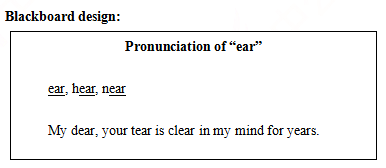 答案:解析:暂无解析
答案:解析:暂无解析 -
第8题:
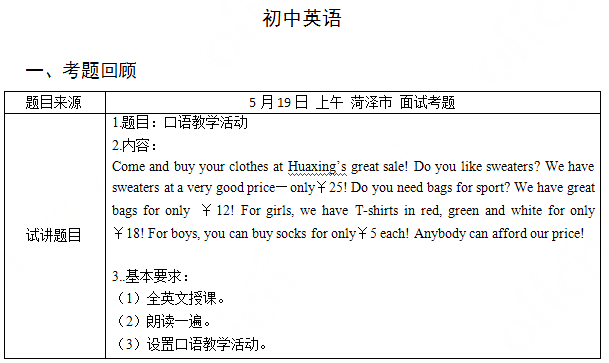
二、考题解析
【教案】
Teaching Aims:
Knowledge aim: Students will master the sentence structure “We have great bags for only ¥12! we have....for only....; You can buy...for only .... ”.
Ability aim: Students can use these sentence structures to apply in their daily life.
Emotional aim: Students will improve their confidence of learning English and not afraid of speaking English in Class.
Teaching Key Points:
Students know the expressions about describing great sale and master the sentence structure.
Teaching Difficult Points:
Students can apply the expressions into daily communication.
Teaching Methods:
Communicative teaching method, task-based teaching method, situational teaching method.
Teaching Aids:
PPT, Blackboard and so on
Teaching Procedures:
Step 1: Warming up
1.Greetings
2.Play a video about an advertisement of Huawei phone and invite students to talk about the content of this video.Then the teacher leads in the topic of “Huaxing’s great sale.”
Step 2: Pre-speaking
1.Show two pictures about Huaxing store and its great sale advertisement.
2.Let students listen to the tape and find out what things are at great sale.
3.Ask students to listen to the tape again and collect the useful expressions about great sale.
Step 3:While-speaking
1. Ask students to read Huaxing’s store’s advertisement actively and vividly.
2. Let students talk about the expressions of great sale.
3. Role-play: students work in pairs to make conversation.Suppose there is a situation that you own a store. One student is shop assistant, the other students is customer. Teacher will give them 8 minutes to prepare it.
Step 4: Post-speaking
Share and evaluation: Invite some students to perform the conversation in the front.
Step 5: Summary & Homework
Summary: let them look at the blackboard and summarize this class.
Homework: Ask students to design a poster of their own store’s great sale and share it next class.
Blackboard design:
 答案:解析:暂无解析
答案:解析:暂无解析 -
第9题:
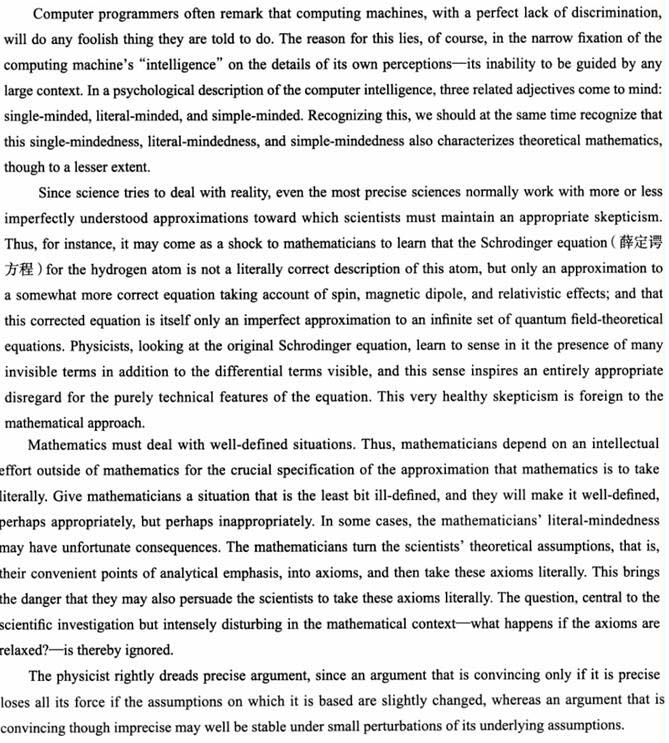
The author suggests that a mathematician asked to solve a problem in an ill-defined situation would first attempt to do which of the following?( )A.Identify an analogous situation.
B.Simplify and define the situation.
C.Vary the underlying assumptions of a description of the situation.
D.Determine what use would be made of the solution provided.答案:B解析:
-
第10题:
单选题Why is small talk described as “non-threatening talk in a threatening situation”? ______.AIt is used by people to encourage those who are confronted with danger.
BIt is used to show that one is enthusiastic and hospitable
CIt is used to create a more friendly atmosphere and to avoid embarrassment.
DIt is used by people to protect others in the threatening situation.
正确答案: A解析:
从文章最后一段“Now it’s time to use small talk as a way of making others feel more comfortable around you,so you don’t look silly standing by the food table alone all night. (现在是时候利用琐谈来使你周围的人感到自在和放松了,这样你也不会傻傻地独自在餐桌边站一个晚上了。)”可以看出,琐谈只是想营造一种轻松友好的气氛。故选C。 -
第11题:
单选题What stage can the following grammar activity be used at?The teacher asked students to arrange the words of sentences into different columns marked subject, predicate, object, object complement, adverbial and so on.APresentation.
BPractice.
CProduction.
DPreparation.
正确答案: A解析: -
第12题:
单选题What stage can the following grammar activity be used at? The teacher askes students to arrange the words of sentences into different columns marked subject, predicate, object, object complement, adverbial and so on. _____APresentation
BPractice
CProduction
DPreparation
正确答案: D解析:
对句子成分进行分析是语法练习阶段。 -
第13题:
which of the following can be used to develop the skill of listening for gist______.A、After listening, the students are required to copy the listening material.
B、After listening, the students are required to write a summary of the text in a few sentences.
C、While listening, the students are required to look at a list of words and circle those used by the speaker.
D、After listening, the students are required to arrange the sentences in the order in which they are mentioned in the text.
参考答案:B
-
第14题:
Passage Four
"Cool" is a word with many meanings. Its old meaning is used to express a temperature that is a little bit cold. As the world has changed, the word has had many different meanings.
"Cool" can be used to express feelings of interest in almost anything. When you see a famous car in the street, maybe you will say, "It's cool. ' You may think, "He's so cool," when you see your favorite football player.
We all maximize (扩大) the meaning of "cool". You can use it instead of many words such as "new" or "surprising". Here's an interesting story we can use to show the way the word is used. A teacher asked her students to write about the waterfall (瀑布) they had visited. On one student's paper was just the one sentence, "It's so cool." Maybe he thought it was the best way to show what he saw and felt.
But the story also shows a scarcity of words. Without "cool", some people have no words to show the same meaning. So it is quite important to keep some credibility (可信性). Can you think of many other words that make your life as colorful as the word "cool"? I can. And I think they are also very cool.
46. We know that the word "cool" has had______.
A. only one meaning
B. no meanings
C. the same meaning
D. many different meanings
正确答案:D46.答案为D 从短文第一段As the world has changed,the word has had many different meanings可知cool有很多不同的意思,D为正确选项。
-
第15题:
What stage can the following grammar activity be used at
The teacher asked students to arrange the words of sentences into different columns raarked subject, predicate, object, object complement, adverbial and so on.
A. Presentation.
B. Practice.
C. Production.
D. Preparation.答案:B解析:考查语法教学内容。做句子成分分析常用于语法练习阶段。故选B。 -
第16题:
Teacher Tom gave the topic of “Send a Letter”, and then asked students to recall the words they learnt such as “post office, stamp, envelope, address, zip code”. Which memorizing strategy did he use?A.Memory systems.
B.Association.
C.Dictionary strategy.
D.Internet assistance.答案:B解析:考查词汇教学
题干的意思是教师汤姆给出了一个话题“寄一封信”,之后让学生们回忆之前学过的生词,如邮局、邮票、信封、地址和邮编。汤姆用了哪种记忆策略?
B选项,是联想法,题干是以一个主题来让学生联想出与之相关的词,是主题联想记忆法,符合题意,故此题的正确选项为B。
A选项,是记忆曲线,不合题意,故排除。
C选项,是字典辅助法,不合题意,故排除。
D选项,是网络辅助法。不合题意,故排除。
故此题的正确选项为B。 -
第17题:
Teacher Tom gave the topic of“Send a Letter”,and then asked students to recall the words they learnt such as“post office,stamp,envelop,address,zip code”.Which memorizing strategy did he use?A.Memory systems.
B.Association.
C.Dictionary strategy.
D.Internet assistance.答案:B解析:考查词汇教学
题干的意思是教师汤姆给出了一个话题“寄一封信”,之后让学生们回忆之前学过的生词,如邮局、邮票、信封、地址和邮编。汤姆用了哪种记忆策略?
B选项,是联想法,题干是以一个主题来让学生联想出与之相关的词,是主题联想记忆法,符合题意,故此题的正确选项为B。
A选项,是记忆曲线,不合题意,故排除。
C选项,是字典辅助法,不合题意,故排除。
D选项,是网络辅助法。不合题意,故排除。
故此题的正确选项为B。 -
第18题:
Let′s think of a situation__________this idiom can be used.A.where
B.which
C.that
D.what答案:A解析:【考情点拨】考查定语从句。【应试指导】句意:咱们来想一个能够应用这个成语的语境。where引导定语从句且在从句中作地点状语,符合题意。 -
第19题:
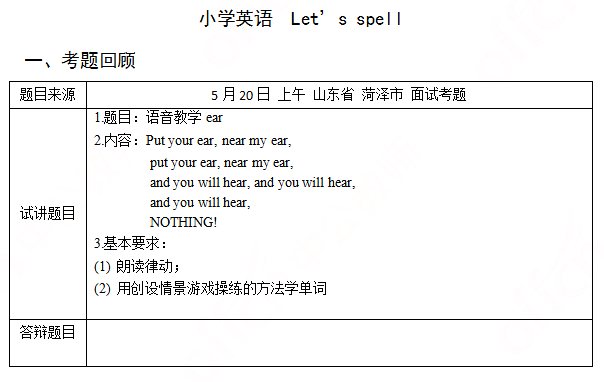
二、考题解析
【教案】
Teaching aims:
Knowledge aim: Students can understand the pronunciation of “ear”, and get some simple spelling rules.
Ability aim: Students can read the words with the pronunciation of “ear” correctly by listening and speaking. Ability of listening and speaking will be improved.
Emotional aim: Students can increase their interests in learning English.
Key and difficult point:
Key points: Students can understand the pronunciation of “ear”, and how how to read the words contain “ear”, such as hear, near and etc.
Difficult points: Students can master the pronunciation of “ear” and read the related words correctly.
Teaching procedure:
Step 1: Warming-up
Greeting the students.
Sing a song: Head shoulder keens and toes.
Step 2: Presentation
1. Show the chant and ask the students the question: Can you find the same letter combination in these words?
2. Listen to the tape and let students pay attention to the pronunciation of “ear”, and then ask the students question: what does “ear” sounds like in these words?
3. Teacher the pronunciation of “ear” ,and let students pay attention to the teacher’s mouth.
4. Game: Play the finger show to practice the new words.
Step 3: Practice
Find more words with “ear” such as tear, dear, clear... and ask students to try to read by themselves and then invite some of them to share with the class. The teacher should act the role of monitor.
Step4: Production
1. Ask students to make up their own sentences by using the words learned today, such as “He hears the bad news,and then his tears falls down. ”.
2. Reading competition: let students to read the chant as quickly as possible, and then let students choose the best one.
Step5: Summary and homework
1. Summary: ask students summary what have learned in the class.
2. Homework:
(1) read these word after class.
(2) Find more words with “ear” and make another chant.
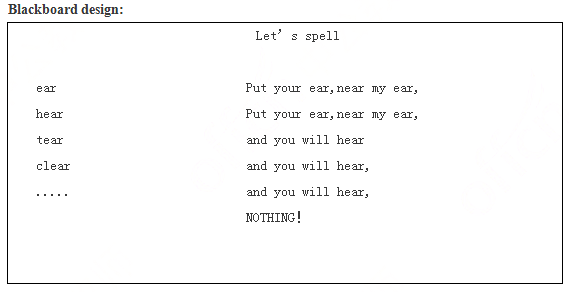 答案:解析:暂无解析
答案:解析:暂无解析 -
第20题:
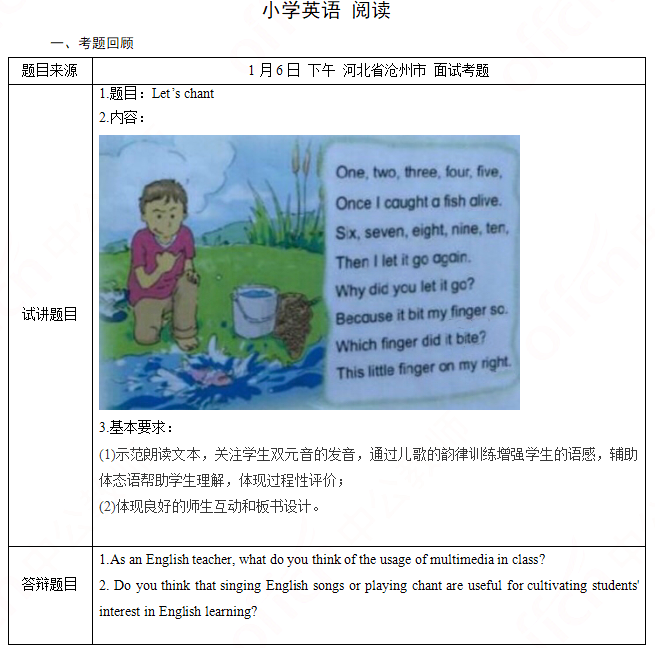
二、考题解析
【教案】
Teaching aims:
Knowledge aim:
Students will master the sound /ai/ in the words “five”, “alive” and so on.
Ability aim:
Students will apply the sound correctly in real communication.
Emotional aim:
Students will be more interest in speaking English.
Key and difficult point:
Key Point: Students will master the sound /ai/ in the words “five”, “alive” and so on.
Difficult Point: Students will apply the sound correctly in real communication.
Teaching procedure:
Step 1: Warming-up
1. Greetings.
2.Play a chant they have learned “tomato, tomato, wash, wash, wash” and lead them to learn another chant this class..
Step 2: Presentation
1. Students watch the picture and tell the teacher what they can see in the picture, and the teacher guide them to present the first part of the chant. Then students watch the picture carefully and predict what’s wrong with the boy, then the teacher guide them to present the last part of the chant.
2. Students observe the sentences and find out what common letters they can find.
3. The teacher teaches them correct pronunciation of the letter “i” in “five”, “right” and so on.
Step 3: Practice
1. Read the pronunciation /ai/ and the words that includes “i” repeatedly.
2. Listen to the tape and follow the tape, paying attention to the intonation of the chant.
3. Students work in pairs to make a chant in 5 minutes.
Step4: Production
1. The teacher writes more words that includes the sound /ai/and students try to read them.
2. Students work in groups to make a story using the picture and the words with the sound /ai/ on the blackboard.
Step5: Summary and Homework
Summary: ask a student to conclude the content of the lesson and summarize with the whole class.
Homework: ask students to search other pronunciation of the letter “i” and list those words accordingly.
Blackboard design:

1. As an English teacher, what do you think of the usage of multimedia in class?
2. Do you think that singing English songs or playing chant are useful for cultivating students' interest in English learning?答案:解析:1.
Multimedia help students to understand our class more smoothly and vividly and enhance their thinking ability. With images, audios and videos, knowledge that is difficult to understand in English is well presented. The students can more truly feel the content of the text, which is helpful to solve difficulties. In the environment of multimedia students can also develop abstract thinking and divergent thinking.
2.
As far as the activity such as singing or chant itself is concerned, it is very interesting and can attract students' attention. The time for students to keep concentrating is limited. If you add such activities as some songs and chants that students like, you can not only attract students' attention, but also cultivate their interest in learning. Therefore, combining knowledge and activities in the classroom allows students to learn while playing and even achieve better effects. -
第21题:
单选题Think about when a teacher handed out a list of twenty Past tense sentences and asked students to discuss and find out the grammatical structures. What is the teacher's grammar teaching method?AInduction.
BPresentation.
CConsolidation.
DDeduction.
正确答案: A解析: -
第22题:
单选题What vocabulary learning strategy does the following activity help to train?The teacher created a situation and asked students to think of words and expressions that can be used in that situation.AAssociation.
BGeneralization.
CCollocation.
DContextualization.
正确答案: D解析: -
第23题:
单选题What vocabulary learning strategy does the following activity help to train? The teacher creates a situation and asks students to think of words and expressions that can be used in that situation. _____AAssociation
BGeneralization
CCollocation
DContextualization
正确答案: D解析:
该教师在词汇教学中创造情境,让学生了解词汇在具体情境下的使用,这属于情境教学法。
